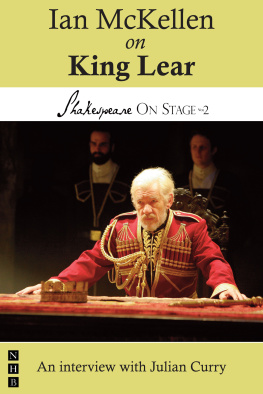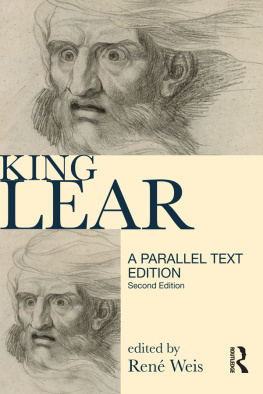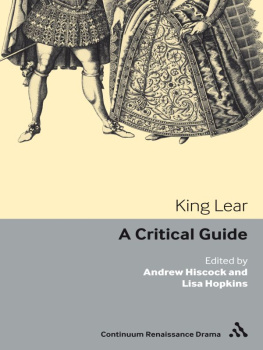POOR TOM
Living King Lear
SIMON PALFREY
The University of Chicago Press
Chicago and London
Simon Palfrey is professor of English literature at Brasenose College, University of Oxford.
The University of Chicago Press, Chicago 60637
The University of Chicago Press, Ltd., London
2014 by The University of Chicago
All rights reserved. Published 2014.
Printed in the United States of America
23 22 21 20 19 18 17 16 15 14 1 2 3 4 5
ISBN-13: 978-0-226-15064-2 (cloth)
ISBN-13: 978-0-226-15078-9 (e-book)
DOI: 10.7208/chicago/9780226150789.001.0001
Library of Congress Cataloging-in-Publication Data
Palfrey, Simon, author.
Poor Tom : living King Lear / Simon Palfrey.
pages cm
Includes bibliographical references and index.
ISBN 978-0-226-15064-2 (cloth : alk. paper) ISBN 978-0-226-15078-9 (e-book)
1. Shakespeare, William, 15641616. King Lear. 2. Edgar (Fictitious character : Shakespeare) I. Title.
PR2819.P35 2014
822.3'3dc23
2013043062
 This paper meets the requirements of ANSI/NISO Z39.48-1992 (Permanence of Paper).
This paper meets the requirements of ANSI/NISO Z39.48-1992 (Permanence of Paper).
To Dad
For he who lives more lives than one
More deaths than one must die.
OSCAR WILDE, Ballad of Reading Gaol
Contents
On Texts
Quotations from King Lear are taken either from The First Folio of Shakespeare: The Norton Facsimile, prepared by Charlton Hinman, 2nd ed. (New York: W. W. Norton, 1996) or from King Lear, 1608 (Pied Bull Quarto) (London: The Shakespeare Association and Sidgwick and Jackson, 1939). Unless otherwise noted, line references are to the through-line-number (TLN) of the Folio edition.
PRELUDE
The Hanging Man
In a corner of one of El Grecos pictures, lost in the folds of sky or curtain, floats a strange mustard-colored sufferer. The figure is naked, arms aloft, lacking a parachute but somehow resisting gravityunless he isnt, and he is falling like a stone through yellow space. He is invisible to the casual eye. El Greco painted him, and then pretended that he hadnt. Perhaps no one else has ever seen him, this barely palpable ghost, wrapped away beneath the pictures nominal theme. Because if we dont magnify the details, he disappears into the yellow drapery wash. But once we have seen him, whether we see him or not when we look once more at the entire picture, he is there. Unborn or deceased or waiting, the homunculus is. The picture is never the same again.
What to do with this image? Perhaps hurry to accommodate him to men or myths that we already know. Maybe it is Christ: witness the thin bent knee, the emaciated cheek and shadow of a beard, the vague suggestion of a loin cloth. And the arms are almost certainly thereunfinished, lost in yellow, but begun at sixty degrees, the painful angle rendered by the slumped head. It must be Christ, suffering and almost forgotten. He is in the last days, perhaps the already-dead days. It is the deposed saviour, strung out in an eternal Easter Saturday, between death and return, denied even a hell to harrow. He is in-between: perhaps once a Christ, perhaps one day once more, but for now, for this worlds visible duration, the hanging man.
When I think of Shakespeare, there is one figure above all that El Grecos hanging man suggests. It is Poor Tom in King Lear. Tom too is called forth from forgotten deeps; he demands attention in his isolation and ongoing excruciation; and then, the gaze of witnesses once upon other things, he disappears.
Did he ever exist? If he did, where did he come from? And if he did, where does he go?
Really, the homunculus is a wash of paint, nothing more. Or a painters joke, a secret to keep from the patron. Like the repetition of some compulsive cartoonist unable to resist doodling, again and again, his woebegone everyman. Let the whimsy be.
Yet the image remains.
The bodys verticality does not work in the usual way of late El Greco, when his saints, madonnas, and martyrs are given impossibly long torsos or limbs, suggesting that some sort of extra-mundane, denaturing stretching is already at work in the heaven-headed body. Instead the verticality is found in the tiny bodys hanging suspension, which might be falling, or might be ascending, but either way the feet do not touch ground. The body merges into and out of surrounding space, such that it can seem a smear of the elements, a brief mirage shaped by the slurry of cosmic matter, rather than a distinct constitution of its own. It is paint and color, or a coalescence of strokes that may at any moment separate into formless matter.
Of course there is no such thing as empty space. The figure is in fact
The here and now, the visible and quotidian, hardly defines possibility. Mundane apprehensions of space and time cannot reach to this vision at all. Seen and not-seen, it is neither inside nor outside, living nor dead, human nor inhuman. Is it in space at all, if its thingness isnt certain, or if it doesnt coincide with others? Is it in time, if it isnt assuredly an event? It is at one glance pure cuspal potentiality; at another glance, silently screaming prevention. It looks like a whirl of nothing, but perhaps this smeared patch is in fact memorys incipience: the nothing awaits; it foreshadows. It is incompossible with the present dispensationbut there are more things in the world than can be measured by the daily senses. Perhaps it promises, however distantly, to resolve the crippling antinomies of our temporal half-life. This floating spiritualized being is here. It is possible.
Unless it isnt. Unless he is flatly impossible, doomed to be strung out in incommensurable solitude.
Surely the price of this kind of presence, a shuttered presence, is awesome and awful loneliness, rarely spoken, even more rarely heard. Does the yellow man exist? Or is he dead? Or waiting?
In more than one way, El Grecos homunculus is lost. I cannot find him. I cannot find where he came from, I cannot place him in his home, he has retreated only god knows where. He came out of my printer, quite unexpectedly. I hadnt called for him at all. I wanted to print the full picture and instead I got a tiny fragment of it, some arbitrary zoom. It kept happening. Instead of neat framed miniatures I got faceless white beards, and tearful eyes glistening like moons in night-ponds, and this sole falling sufferer. And now I dont know which picture or mural it was, and because the yellow man is so small, and El Grecos jaundiced mustard color so ubiquitous, he has retreated back into nonbeing. And so here he is, falling through mustard space, through the casing air and the viewless winds, this single image the only trace of his possibility. All there is of him is my creased printout, taped to a board, curling and perilous. The image gathers a curious twinned pathos, partly of unwonted survival, partly of accident. Or rather, of an accident that has somehow stolen the gift of duration. Perhaps better to call it a life.
Toms a cold.
INTRODUCTION
This book begins with a single supposition. That deep in the secret recesses of Shakespeare is the figure of King Lears Edgar-Tom: passionate subject of, and passionately subject to, Shakespearean history and futurity and theatrical poetics. It is a figure without conventional limits, a limitlessness that corresponds to the unhoused, barely imaginable ambitions of Shakespeare for his art.
The Edgar of my book is not so much a character as a nest of possibilities: at every moment intensely centered, and in this centering stretched and shattered and shared; at every moment mutating into other forms, human and nonhuman. Consequently, this plaything is burdened more than any other with the experience of suffering and the difficulty of release.
Next page







 This paper meets the requirements of ANSI/NISO Z39.48-1992 (Permanence of Paper).
This paper meets the requirements of ANSI/NISO Z39.48-1992 (Permanence of Paper).